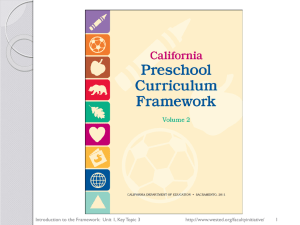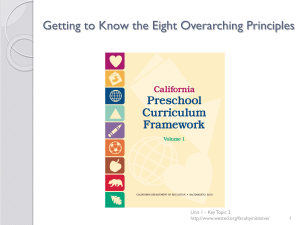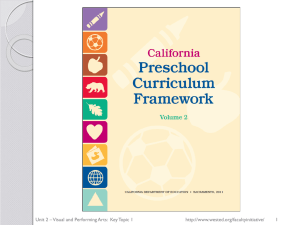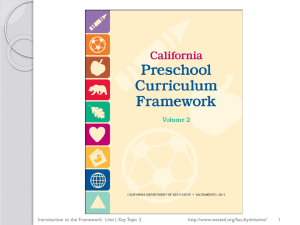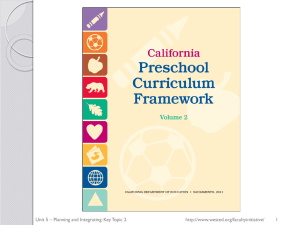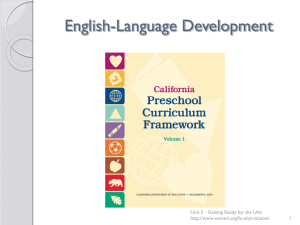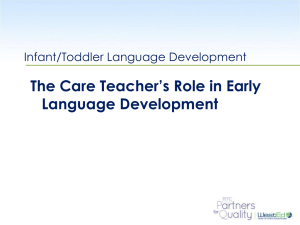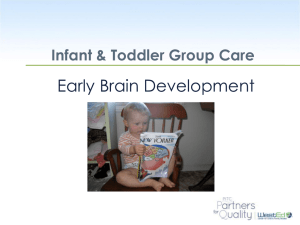Full of the Companion PowerPoint
advertisement
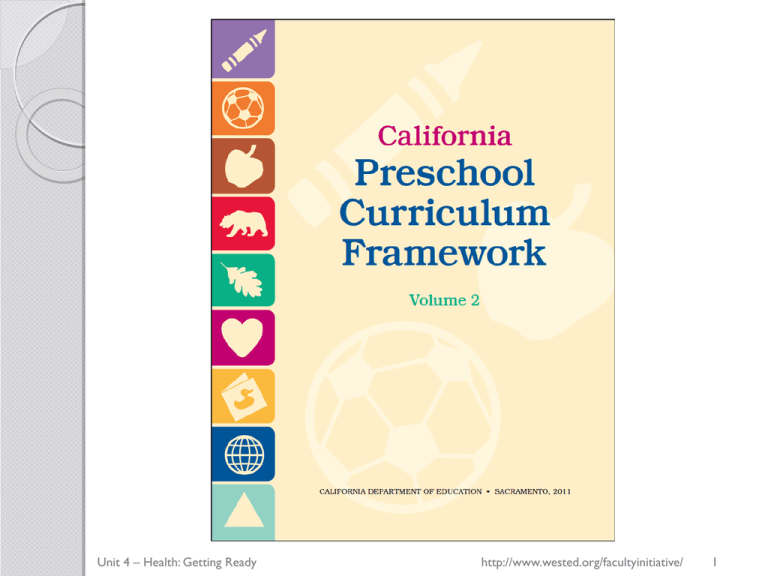
Unit 4 – Health: Getting Ready http://www.wested.org/facultyinitiative/ 1 Health The health domain in the California Preschool Curriculum Framework, Volume 2 is: A companion to the same domain in the California Preschool Learning Foundations, Volume 2. A guide for teachers in planning curriculum that supports physical development. Organized with the same strands and substrands as the foundations. Unit 4 – Health: Getting Ready http://www.wested.org/facultyinitiative/ 2 Health The strands include: Health Habits: focuses on basic hygiene, oral health, knowledge of wellness, and safety in the sun. Learning occurs primarily in the context of the children’s daily routines Safety: promotes children’s safety awareness. It addresses children’s ability to follow safety rules, emergency routines, and transportation and pedestrian safety rules Nutrition: focuses on children developing healthy eating habits Unit 4 – Health: Getting Ready http://www.wested.org/facultyinitiative/ 3 Health Health Habits Substrand 1.0 Substrand 2.0 Substrand 3.0 Substrand 4.0 Basic Hygiene Oral Health Knowledge of Wellness Sun Safety Safety Substrand 1.0 Injury Prevention Unit 4 – Health: Getting Ready http://www.wested.org/facultyinitiative/ 4 Health Nutrition Substrand 1.0 Nutrition Knowledge Substrand 2.0 Nutrition Choices Substrand 3.0 Self-Regulation of Eating Unit 4 – Health: Getting Ready http://www.wested.org/facultyinitiative/ 5 Health The health development domain in the California Preschool Curriculum Framework, Volume 2 contains: Guiding principles Suggestions for environments and materials Vignettes Teachable moments Interactions and strategies Strategies for engaging families Research highlights Questions for reflection Unit 4 – Health: Getting Ready http://www.wested.org/facultyinitiative/ 6 Health Handwashing What were your family’s handwashing practices? Do you remember seeing your parents or siblings washing their hands at specific times? Were there specific times, such as right before meals, when you or your family members were reminded to wash hands? Unit 4 – Health: Getting Ready http://www.wested.org/facultyinitiative/ 7 Health Brushing teeth How often and when were you taught to brush your teeth? Were you reminded by your family or others to floss? Unit 4 – Health: Getting Ready http://www.wested.org/facultyinitiative/ 8 Health Mealtime Did your family eat meals together? Which ones? Around a table or special place? How was food put onto plates? Individually and then brought to the table? Served at the table? Did the family eat from shared dishes? What were some foods that your family enjoyed together? What were some special foods that were related to holidays or celebrations? Unit 4 – Health: Getting Ready http://www.wested.org/facultyinitiative/ 9 Health Safety Are there safety rules that you remember from when you were a child? Were these rules from your family or from school? What were you taught about crossing streets? Electrical outlets? Using appliances? What do you remember learning about staying safe while participating in sports? Unit 4 – Health: Getting Ready http://www.wested.org/facultyinitiative/ 10 What did you hear that you had not known or thought about? How did this help you understand your own health, safety, and nutrition habits? What did you learn about how family influences might impact how children build health-promoting habits? How will this influence your approach to teaching health, safety, and nutrition to young children? Unit 4 – Health: Getting Ready http://www.wested.org/facultyinitiative/ 11 Unit 4 – Health: Key Topic 1 http://www.wested.org/facultyinitiative/ 1 Health Reasons to foster healthy lifestyles in young children: 1. “Preschool education about health can begin a lifelong process of learning about oneself, relationships to others, and the world.” 2. “Preschool children’s experiences with their health and ways to improve it . . . enhance their desire and ability to make healthy decisions throughout their lives.” Unit 4 – Health: Key Topic 1 http://www.wested.org/facultyinitiative/ 2 Health Did any of you choose the same sentences? Were there others that you considered? When you hear all about all three paragraphs, what does it suggest about helping young children develop healthpromoting habits? Unit 4 – Health: Key Topic 1 http://www.wested.org/facultyinitiative/ 3 Health The strands defined, include: Health Habits: focuses on basic hygiene, oral health, knowledge of wellness, and safety in the sun. Learning occurs primarily in the context of the children’s daily routines. Safety: promotes children’s safety awareness. It addresses children’s ability to follow safety rules, emergency routines, and transportation and pedestrian safety rules. Nutrition: focuses on children developing healthy eating habits. Unit 4 – Health: Key Topic 1 http://www.wested.org/facultyinitiative/ 4 Health Health Habits Substrand 1.0 Substrand 2.0 Substrand 3.0 Substrand 4.0 Basic Hygiene Oral Health Knowledge of Wellness Sun Safety Safety Substrand 1.0 Injury Prevention Unit 4 – Health: Key Topic 1 http://www.wested.org/facultyinitiative/ 5 Health Nutrition Substrand 1.0 Nutrition Knowledge Substrand 2.0 Nutrition Choices Substrand 3.0 Self-Regulation of Eating Unit 4 – Health: Key Topic 1 http://www.wested.org/facultyinitiative/ 6 Health California Preschool Curriculum Framework, Volume 2 Domain Guiding Principles (pp. 227–228) Environments and Materials (pp. 229–231) Summary of the Strands and Substrands (pp. 231–232) Strands (pp. 233, 252, 262) Substrands (pp. 234, 238, 241, 246, 253, 263, 267) Research Highlights (pp. 230, 234, 235, 246, 253, 257, 262, 270) Unit 4 – Health: Key Topic 1 http://www.wested.org/facultyinitiative/ 7 Health California Preschool Curriculum Framework, Volume 2 Engaging Families (pp. 250, 260, 274) Questions for Reflection (pp. 251, 261, 275) Vignettes and teachable moments for each substrand Interactions and strategies for each substrand Teacher Resources (pp. 278-279) Unit 4 – Health: Key Topic 1 http://www.wested.org/facultyinitiative/ 8 Health Review: Summary of the health strands and substrands on pages 231–232 of the California Preschool Curriculum Framework, Volume 2. Appendix of the California Preschool Learning Foundations, Volume 2 on pages 111–112, which is a summary of the strands, substrands, and foundations for the health domain. Unit 4 – Health: Key Topic 1 http://www.wested.org/facultyinitiative/ 9 Health The foundations are the what: goal-like statements that describe what children typically learn and develop with optimal support. The curriculum framework is the how: provides guidance for how teachers can intentionally support this learning and development. Unit 4 – Health: Key Topic 1 http://www.wested.org/facultyinitiative/ 10 Health What stood out for you when you looked at the organizational charts of the health domain? What surprised you? Which substrand had elements that were the most familiar to you? The most unfamiliar? What patterns did you see in the organizational structure of the domain? How might you use this organizational chart of the domain as a reference for your work in planning health environments and learning experiences for children? Unit 4 – Health: Key Topic 1 http://www.wested.org/facultyinitiative/ 11 Health Guiding Principles Health knowledge if individualized. Preschool children and their families possess diverse backgrounds and cultural practices. Learning about health practices has a language component. Children’s personal health status affects their ability to learn and develop in all domains. Unit 4 – Health: Key Topic 1 http://www.wested.org/facultyinitiative/ 12 Health Guiding Principles The overall theme of health education for preschool is personal health. Children learn through their experiences, including play, routines and scripts, modeling, and developing sustaining relationships at preschool. Practicing scripts, or behavioral rules, can foster development of certain healthpromoting behaviors or skills. Unit 4 – Health: Key Topic 1 http://www.wested.org/facultyinitiative/ 13 Health Guiding Principles The preschool program provides both indoor and outdoor environments that are safe and appropriate, challenging, and inviting for all children. Teachers help children feel secure by assuring them that there are adults who will take care of them. Unit 4 – Health: Key Topic 1 http://www.wested.org/facultyinitiative/ 14 In one or two sentences, state what was the most memorable thing you learned about the health domain. What was new information or unfamiliar in this domain? Are there topics in this domain that you need or want to find out more about? How can you do that? How will this affect your work with young children now or in the future? Unit 4 – Health: Key Topic 1 http://www.wested.org/facultyinitiative/ 15 Unit 4 – Health: Key Topic 2 http://www.wested.org/facultyinitiative/ 1 Health Daily routines as curriculum “Such routines offer opportunities for children to build language skills, to learn the rituals of sharing time with others, to relate one action in a sequence to another, to coordinate emerging fine and gross motor skills, and to learn and practice health and safety procedures. “ (p. 25) California Preschool Curriculum Framework,Volume 2 Unit 4 – Health: Key Topic 2 http://www.wested.org/facultyinitiative/ 2 Health Glossary at the end of the domain (pp. 290–293) Suggested environments and materials (pp. 229–231) Unit 4 – Health: Key Topic 2 http://www.wested.org/facultyinitiative/ 3 Health Unit 4 – Health: Key Topic 2 http://www.wested.org/facultyinitiative/ 4 Health Where are the routines? What examples from Handout 1 would support the development of health habits, safety, and nutrition in those routines? Unit 4 – Health: Key Topic 2 http://www.wested.org/facultyinitiative/ 5 What was hard about doing this? What worked well in your pair or small group? What did you think about that you had not thought much about before doing this exercise? What was familiar and comfortable in this exercise? What are some new ideas that emerged in this exercise? How can you find out more about them? How will this impact the work you do or will do with young children and their families? Unit 4 – Health: Key Topic 2 http://www.wested.org/facultyinitiative/ 6 Unit 4 – Health: Key Topic 3 http://www.wested.org/facultyinitiative/ 1 Health Intentional teaching Teaching that is done “with knowledge and purpose to ensure that young children acquire the knowledge and skills they need…” (p. 7) California Preschool Curriculum Framework,Volume 2 Unit 4 – Health: Key Topic 3 http://www.wested.org/facultyinitiative/ 2 Health Scaffolding Supporting children’s learning of new skills or concepts until they are able to complete a skill or understand a concept on their own and the supports are withdrawn. Scripts Rules and sequence(s) of behavior associated with a given situation. (p. 293) California Preschool Curriculum Framework,Volume 2 Unit 4 – Health: Key Topic 3 http://www.wested.org/facultyinitiative/ 3 Health The “preschool health foundations represent a vision of young children's developmental progress, not an expectation.” (p. 226) California Preschool Curriculum Framework,Volume 2 Important to recognize that children entering preschool may have varied backgrounds and experiences with health habits, safety, and nutrition. The teacher’s role is to support children, beginning where they are and with respect for family and community practices. Unit 4 – Health: Key Topic 3 http://www.wested.org/facultyinitiative/ 4 Health Group 1 (20 interactions and strategies) Basic Hygiene (7) Oral Health (6) Knowledge of Wellness (7) Group 2 (19 interactions and strategies) Sun Safety (9) Injury Prevention (10) Group 3 (20 interactions and strategies) Nutrition Knowledge (7) Nutrition Choices (7) Self-Regulation of Eating (6) Unit 4 – Health: Key Topic 3 http://www.wested.org/facultyinitiative/ 5 Health Consider which interactions and strategies would best be opportunities for intentional teaching: 1. Planned learning experiences, such as story time, small group art activity, etc. 2. Intentional preparation of environments and materials . 3. Intentional responses to in-the-moment interactions, interactions with other teachers, or those interactions requiring shifts in the role of the teacher. Unit 4 – Health: Key Topic 3 http://www.wested.org/facultyinitiative/ 6 Health What did you learn about intentional teaching? What did you learn about this domain? Was anything surprising? Were there any recommended interactions and strategies that are different from those your family practices? Which ones and how would you want them approached in an early care and education setting for yourself or a child in your family? What was familiar, what was new, and what was challenging? How will you use this in your work now or in the future? Unit 4 – Health: Key Topic 3 http://www.wested.org/facultyinitiative/ 7 Where were you surprised or challenged? How did the discussion help you reflect on your engagement with this learning experience? Were there some questions that were particularly thought- provoking? Which ones were they and what was some of your thinking? How will this discussion and/or this reflection help you in your work with young children now or in the future? Unit 4 – Health: Key Topic 3 http://www.wested.org/facultyinitiative/ 8 Unit 4 – Health: Key Topic 4 http://www.wested.org/facultyinitiative/ 1 Health Universal Design for Learning Provides for multiple means of representation, multiple means of engagement, and multiple means of expression. (page 14) California Preschool Curriculum Framework, Volume 2 Unit 4 – Health: Key Topic 4 http://www.wested.org/facultyinitiative/ 2 Health Multiple means of representation Providing information in a variety of ways to meet the learning needs of all children Multiple means of expression Allowing children to use alternative ways to communicate or demonstrate what they know or what they are feeling Multiple means of engagement Offering choices in the setting or program that facilitate learning by building on children’s interests (page 14) California Preschool Curriculum Framework, Volume 2 Unit 4 – Health: Key Topic 4 http://www.wested.org/facultyinitiative/ 3 Health Create a visual representation to show the adaptations you have identified for your strand. Show examples of each of the three elements of universal design: ◦ multiple means of representation ◦ multiple means of engagement ◦ multiple means of expression Unit 4 – Health: Key Topic 4 http://www.wested.org/facultyinitiative/ 4 Health Which adaptations stood out for you? Which adaptations do you think you could easily use? Which ones might seem more challenging? Why? What were some examples of multiple means of representation, multiple means of engagement, or multiple means of expression that crossed all three health strands? Unit 4 – Health: Key Topic 4 http://www.wested.org/facultyinitiative/ 5 Health What do you plan to keep in mind when planning ways to modify or adapt the learning environment and experiences to ensure that children with disabilities participate in the health domain? Unit 4 – Health: Key Topic 4 http://www.wested.org/facultyinitiative/ 6 Health What information from the presenter(s) caught your attention or stood out for you? What are you most confident about in supporting the development of children with disabilities in the health domain? What new or different perspectives do you have? How has this presentation been helpful? What do you want to keep in mind when you are planning ways to modify or adapt the learning environment and experiences for children with disabilities to ensure their access to all aspects of the health domain? Unit 4 – Health: Key Topic 4 http://www.wested.org/facultyinitiative/ 7 Health “Individualization of learning includes all children.” “…temperament, family and cultural experiences, language experiences, personal strengths, interests, abilities, and dispositions . . .” (page 8) California Preschool Curriculum Framework,Volume 2 Unit 4 – Health: Key Topic 4 http://www.wested.org/facultyinitiative/ 8 Health What stands out from developing these lists? What was easy about identifying how interactions and strategies addressed individualizing curriculum? What was more challenging? Do you think it would be more difficult for you to individualize the curriculum in one of the health strands or substrands more than the others? Which one and why? What is a first step you can take to find more resources or support in individualizing the curriculum for that strand or substrand? Unit 4 – Health: Key Topic 4 http://www.wested.org/facultyinitiative/ 9 Health “Family and community partnerships create meaningful connections.” (pages 7-8) California Preschool Curriculum Framework,Volume 2 Unit 4 – Health: Key Topic 4 http://www.wested.org/facultyinitiative/ 10 Health What considerations appeared most frequently? Which ones require learning specific information about the families related to their background and beliefs about health, safety, and nutrition practices in the home and community? Which ones seem especially important based on your experiences with families? What are some concrete steps you would take as a teacher to find out about families’ experiences, culture, beliefs, and interests relating to health, safety, and nutrition? Unit 4 – Health: Key Topic 4 http://www.wested.org/facultyinitiative/ 11 What part of this class session stood out most for you today? Which ideas or concepts from today’s work reinforced what you have already learned or experienced? Which ones gave you a new perspective or insight? How might you apply a new idea or perspective to your work now or in the future? What information or support do you need? What is a first step you could take to locate this support or information? What steps could you take to start applying the new idea or perspective? Unit 4 – Health: Key Topic 4 http://www.wested.org/facultyinitiative/ 12 Health Identify two resources that will help you: ◦ Ensure that children with disabilities are fully participating in the health curriculum. ◦ Develop additional strategies for individualizing the health curriculum. ◦ Involve families in their children’s learning related to health habits. Write a paper on each resource, summarizing what you learned and how you can use the information in your work. Unit 4 – Health: Key Topic 4 http://www.wested.org/facultyinitiative/ 13 Unit 4 – Health: Key Topic 5 http://www.wested.org/facultyinitiative/ 1 Health Research Highlights Cleaning and disinfecting (p. 230) Hand washing (p. 234) Adjusting to environmental heat (p. 246) Child injury (p. 253) Choking (p. 257) Eating preferences and habits (p. 262) Obesity (p. 267) Food allergies (p. 270) Unit 4 – Health: Key Topic 5 http://www.wested.org/facultyinitiative/ 2 Health Review “Teacher Resources” (pp. 278–279) California Preschool Curriculum Framework, Volume 2. Additional resources: California Childcare Health Program (CCHP) (http://www.ucsfchildcarehealth.org/) http://www.childhealthonline.org Healthy Childcare Magazine (http://www.healthychild.net/) National Resource Center for Health and Safety in Child Care and Early Education (http://nrckids.org/) Unit 4 – Health: Key Topic 5 http://www.wested.org/facultyinitiative/ 3 Health Prepare a summary of the Web site, including: Name and URL for the Web site Sponsoring or funding source Resources available on the Web site Examples of resources (either hardcopy or selected URLs for the resources) Ways in which this Web site and/or its resources would be helpful in working on developing healthy habits for young children Ways in which the Web site could be used in working with families of young children Unit 4 – Health: Key Topic 5 http://www.wested.org/facultyinitiative/ 4 What was most helpful about this learning experience? What would you like to explore more? Where would you need help in further explorations? How will this information influence your work with young children and their families now or in the future? Unit 4 – Health: Key Topic 5 http://www.wested.org/facultyinitiative/ 5
